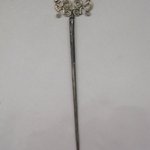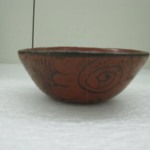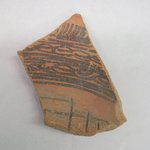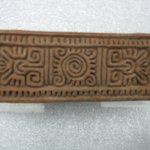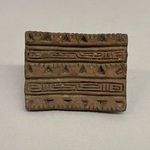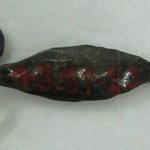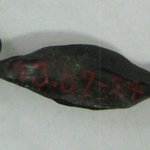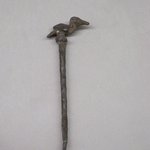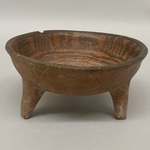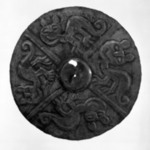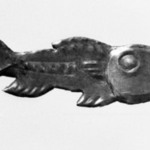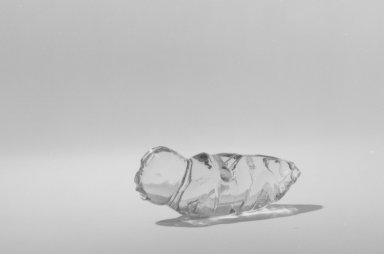
Pendant in the Form of a Grasshopper
Arts of the Americas
Chapultepec, or “Grasshopper Hill,” was the first Mexica settlement in the Valley of Mexico, and this carved aquamarine grasshopper pendant may have a symbolic association with the site. Located on the western shore of Lake Texcoco, Chapultepec Hill was a source of fresh water for the capital city of Tenochtitlán. It was also a sacred mountain shrine for Mexica rulers, who had their portraits carved in the rock cliffs. For the Mexica, grasshoppers signified the end of the rainy season, when crops started to grow.
Chapultepec, o “Cerro Saltamontes,” fue el primer asentamiento Mexica en el Valle de México, y este pendiente en forma de saltamontes de aguamarina tallada puede tener una asociación simbólica con el lugar. Ubicado en la costa oeste del Lago Texcoco, el cerro de Chapultepec era una fuente de agua fresca para la ciudad capital de Tenochtitlán. Era también un santuario de montaña sagrado para los gobernantes Mexica, quienes hacían tallar sus retratos en los acantilados de piedra. Para los Mexica, los saltamontes significaban el fin de la temporada lluviosa, cuando los cultivos comenzaban a crecer.
Chapultepec, o “Cerro Saltamontes,” fue el primer asentamiento Mexica en el Valle de México, y este pendiente en forma de saltamontes de aguamarina tallada puede tener una asociación simbólica con el lugar. Ubicado en la costa oeste del Lago Texcoco, el cerro de Chapultepec era una fuente de agua fresca para la ciudad capital de Tenochtitlán. Era también un santuario de montaña sagrado para los gobernantes Mexica, quienes hacían tallar sus retratos en los acantilados de piedra. Para los Mexica, los saltamontes significaban el fin de la temporada lluviosa, cuando los cultivos comenzaban a crecer.
CULTURE
Aztec Style
MEDIUM
Aquamarine (Beryl)
DATES
late 19th or early 20th century (probably)
DIMENSIONS
13/16 x 7/8 x 2 1/16 in. (2.1 x 2.2 x 5.2 cm) (show scale)



COLLECTIONS
Arts of the Americas
ACCESSION NUMBER
39.56
CREDIT LINE
Dick S. Ramsay Fund
MUSEUM LOCATION
This item is not on view
CAPTION
Aztec Style. Pendant in the Form of a Grasshopper, late 19th or early 20th century (probably). Aquamarine (Beryl), 13/16 x 7/8 x 2 1/16 in. (2.1 x 2.2 x 5.2 cm). Brooklyn Museum, Dick S. Ramsay Fund, 39.56. Creative Commons-BY (Photo: Brooklyn Museum, 39.56_acetate_bw.jpg)
IMAGE
overall, 39.56_acetate_bw.jpg. Brooklyn Museum photograph
"CUR" at the beginning of an image file name means that the image was created by a curatorial staff member. These study images may be digital point-and-shoot photographs, when we don\'t yet have high-quality studio photography, or they may be scans of older negatives, slides, or photographic prints, providing historical documentation of the object.
RIGHTS STATEMENT
Creative Commons-BY
You may download and use Brooklyn Museum images of this three-dimensional work in accordance with a Creative Commons license. Fair use, as understood under the United States Copyright Act, may also apply.
Please include caption information from this page and credit the Brooklyn Museum. If you need a high resolution file, please fill out our online application form (charges apply).
For further information about copyright, we recommend resources at the United States Library of Congress, Cornell University, Copyright and Cultural Institutions: Guidelines for U.S. Libraries, Archives, and Museums, and Copyright Watch.
For more information about the Museum's rights project, including how rights types are assigned, please see our blog posts on copyright.
If you have any information regarding this work and rights to it, please contact copyright@brooklynmuseum.org.
RECORD COMPLETENESS
Not every record you will find here is complete. More information is available for some works than for others, and some entries have been updated more recently. Records are frequently reviewed and revised, and we welcome any additional information you might have.
